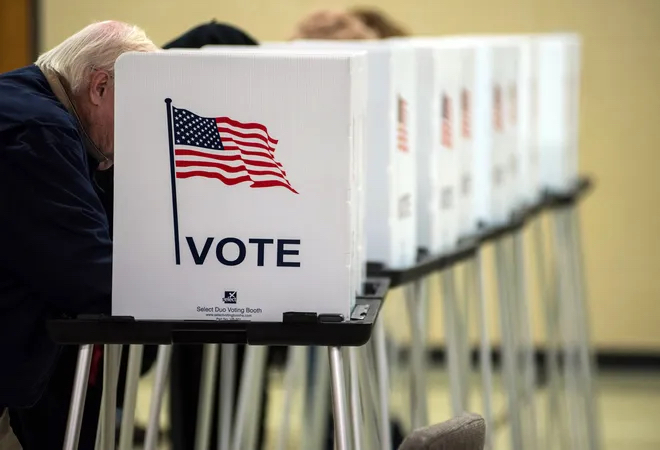Voting across the nation: What we know now
Courtesy of Brian Wells/Times Herald
With the midterm elections now in the rearview, the results are starting to pour in as all votes are counted across the nation.
Many went into Election Day on Nov. 8 fearful and worried, unsure how the U.S. government stood after the polls closed. On many voters’ minds were the topics of abortion and womens’ rights, inflation, justice, the economy and, at the root of everything, the state of our democracy.
Why was this election so important?
For one, since the Supreme Court overturned Roe v. Wade in Dobbs v. Jackson Women’s Health Organization this past summer, abortion rights and women’s healthcare were given back to the states to legislate rather than being federally protected, like it was under Roe. For another, inflation rose dramatically over the past year, with rising gas and food prices requiring many Americans to tighten their belts.
Various states had key elections for the U.S. House of Representatives, the U.S. Senate and their own governorships. Below is a brief rundown of some swing states and what we know now about their results.
Ohio
In Ohio, there was a gubernatorial election between incumbent Republican Mike DeWine and Democratic nominee Nan Whaley, with incumbent Governor Mike DeWine winning once again by a little less than a 30-point margin. Similarly, a Senate seat was open in Ohio after Republican Senator Rob Portman announced he would not be running again. The race was between election denier and Trump-endorsed Republican candidate J.D. Vance and unpopular Democratic candidate Tim Ryan, ending with a win by J.D. Vance by about seven percentage points. However, things were looking up for Democrats in the House, with Democrats unexpectedly winning five districts after unseating incumbent Republican Representative Steve Chabot in OH-1. On the other hand, Republicans won all three open seats on the Ohio Supreme Court, solidifying their majority there.
Pennsylvania
Republicans had a rough day in Pennsylvania, with a win by former Lt. Gov. Democrat John Fetterman over Trump-backed Republican candidate Mehmet Oz for the open Senate seat. This was a key seat for the Democrats to win, as Pennsylvania is a swing state, having gone for both Trump and Biden in 2016 and 2020, respectively. Similarly, the gubernatorial race was decisive, with popular Democrat nominee Josh Shapiro bringing home the bacon over Republican Doug Mastriano by about 13 points. As for the House, nine of the 17 seats up for election were taken by Democratic nominees.
Wisconsin
Wisconsin was a bit of an interesting case. While incumbent Republican Senator Ron Johnson did hold on to his Senate seat, he did so by barely one point against Lt. Gov. Democrat Mandela Barnes. On the other hand, Democratic incumbent Tony Evers beat Trump-backed Republican Tim Michels by 3.4% in the gubernatorial race. The House, too, was a mixed bag, with primarily red districts across the state and two little blue spots, due to gerrymandering.
Georgia
This state’s Senate election has remained a mystery as Republican nominee and former Heisman Trophy winner Herschel Walker went up against incumbent Democratic pastor Raphael Warnock—they are now headed toward a runoff election because neither candidate won over 50% of the vote. However, incumbent Republican governor Brian Kemp kept his seat, beating Democratic candidate Stacey Abrams by almost 10 points. The House was, too, a mixed bag, but all incumbents in both parties held on to their seats.
There were many other interesting outcomes from this election cycle. For example, a red wave washed across Florida, probably due to growing popularity for Gov. Ron DeSantis, who won his own gubernatorial election by almost 20 points. However, Republicans did not experience the massive sweep of the House and Senate that they had been vying and hoping for prior to Election Day.
But, one may ask, why does this matter to students? How does it affect us?
Well, many students are widely concerned about the election results and the impacts they will have on their own lives, including third-year political science student Paola Espinoza, who said that they voted on the reproductive rights issue. Espinoza explained to me their fears: “My biggest concern during this election, as I’m sure everyone else with a uterus [could relate], was abortion. The overturning of Roe v. Wade put people like myself and others in danger. Ohio is notorious for trying to take away bodily autonomy, and I was not keen to stand idly by when I know my vote would count for something.”
Another student, fourth-year political science major Cameron Tong, expressed other worries: “My main concern was how American democracy would would survive if governors, secretaries of state and members of state legislatures who wanted to overhaul the democratic process were given the ability to build a system that circumvents the will of the voters, more than gerrymandering already does.”
Whether you voted on the grounds of abortion rights, inflation, immigration or something else, each person’s ability to vote—and therefore to be involved directly with our democratic system—is a right, and it is important to exercise that right. Though the election is now over, it is important to remember that all who voted exercised their civil duty; all we can do now is wait for final results, cross our fingers for the best and hope that democracy prevails over everything else.

Grace (she/her) is a third-year student majoring in history and political science with minors in English and philosophy. In addition to her role at The...


